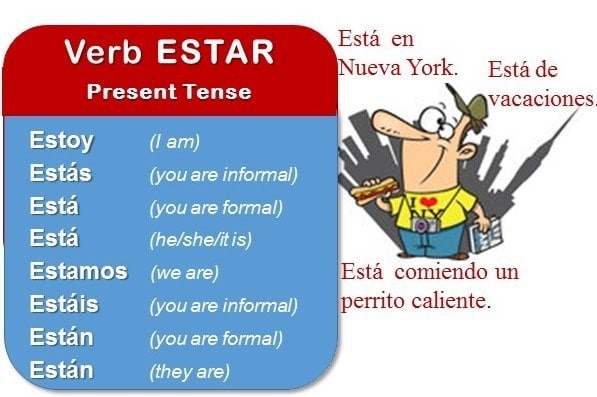Spanish verb ESTAR is one of the two ways we have to say «to be» in Spanish. In this lesson, we will learn how to conjugate this verb in the present indicative and how to use it. Remember that the other way to say «to be» in Spanish is verb SER, click on the link if you want to see more about it.
Verb ESTAR conjugation
Here you have how to form the present tense of verb ESTAR,

As you can see the present indicative of the verb ESTAR is irregular in the first person «I», it also has an extra accent.
That extra accent is very important, compare the following examples.
Esta casa es muy bonita (This house is very nice).
Carlos está de vacaciones (Carlos is on holidays).
Notice that «estáis» is only used in Spain, in America «están» is used instead.
Click on the link if you want to see the whole ESTAR conjugation.
How is verb ESTAR used
1. Before adjectives to describe a temporary state or condition, such as help and emotions.
Tu cuarto está sucio (your bedroom is dirty).
Estoy enfermo (I am sick).
Estamos muy cansados (We are very tired).
Los tomates están verdes (The tomatoes are unripe).
2. To talk about location, permanent or temporal.
La Puerta del Sol está en Madrid (La Puerta del Sol is in Madrid).
Estamos en el zoo (we are at the zoo).
Los niños están en el colegio (The children are in the school).
3. To talk about marital status.
Estamos casados (We are married).
Enrique está soltero (Enrique is single).
Estoy divorciada (I am divorced).
4. Before a gerund to form the continuous tenses:
Carlos está todavía trabajando (Carlos is still working).
Están escuchando las noticias (they are listening to the news).
Estoy corriendo una maratón (I’m running a marathon).
5. In many expressions:
- Estar de pie (to be standing).
- Estar de vacaciones (to be on holiday).
- Estar de viaje (to be on a trip).
- Estar de acuerdo (to agree).
- Estar de buen/mal humor (to be in a good/bad mood).
- Estar a sus anchas (to be comfortable).
Differences between SER and ESTAR

Some adjectives, like «rico» change their meaning when used with either “ser” or “estar». Click on the like to see a list of adjectives that change their meaning with ser and estar.
Spanish exercises
Now it’s time to practice everything you’ve learned with the exercises below. Remember that you can contact your tutor if you have any questions about the verb ESTAR. Don’t you have a Spanish tutor online yet?
Leave us a comment if you want us to prepare more exercises on this topic. Thanks a lot to help us to be better.